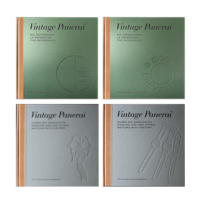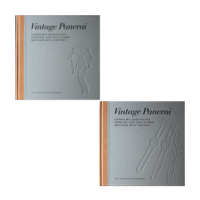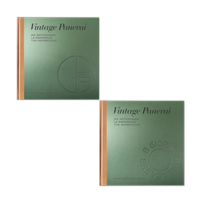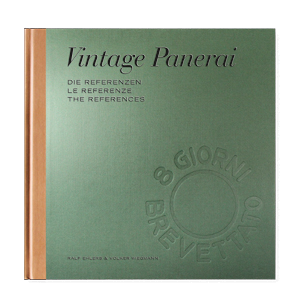Allgemein
The 6152/1 – a Panerai icon…
by Volker on Feb.28, 2016, under Allgemein
…and carrier of the brand’s DNA until today and in the future.
 Watches of the reference 6152/1 are featured in four of the twelve chapters of our new “The References” books and part of the second volume (1950’s-1960’s). The 6152/1 watches with Rolex movements are featured in chapter VIII.I and VIII.II, 6152/1 watches with Angelus movements are featured in chapter X.III and X.IV.
Watches of the reference 6152/1 are featured in four of the twelve chapters of our new “The References” books and part of the second volume (1950’s-1960’s). The 6152/1 watches with Rolex movements are featured in chapter VIII.I and VIII.II, 6152/1 watches with Angelus movements are featured in chapter X.III and X.IV.
The photo shows a 6152/1 with Rolex movement, “Luminor Panerai” dial and crown-protecting device (chapter VIII.II, page 962-963). Enjoy reading! Our new “The Reference” books are available only in our bookstore.
Famous watches inside.
by Volker on Feb.26, 2016, under Allgemein
 Our new “The References” books feature five watches of famous italian WW2 veterans. They wrote naval history with their SLC and frogmen missions in the mediterranean sea, which are linked to the history of these legendary watches. Both volumes – 1392 pages – are available only in our bookstore.
Our new “The References” books feature five watches of famous italian WW2 veterans. They wrote naval history with their SLC and frogmen missions in the mediterranean sea, which are linked to the history of these legendary watches. Both volumes – 1392 pages – are available only in our bookstore.
The photo shows page 354-355 / chapter II.III of the first volume (1930’s-1940’s / 696 pages) featuring watches of the Reference 3646 / Type C.
Enjoy reading!
Coffee. Table. Book.
by Volker on Feb.26, 2016, under Allgemein
 Our new “The References” 1950’s-1960’s book (volume two / 696 pages). Available in our bookstore.
Our new “The References” 1950’s-1960’s book (volume two / 696 pages). Available in our bookstore.
Watches, compasses and depth gauges from Guido Panerai & Figlio (chapter VI – XI plus chapter XII on buckles and straps) produced in the 1950’s – 1960’s.
Enjoy reading!
Our book “The References” is available again
by Volker on Feb.19, 2016, under Allgemein
 By the end of 2015 our Vintage Panerai database counted a total of 377 entries, which we have recorded since 2003. The summary of our research about the watches made by Guido Panerai & Figlio from the 1930’s to the 1960’s are published in the 2nd edition of our new “The References” books in 2016, in which 70 watches plus several compasses and depth gauges are published on 1392 pages in two volumes – visit our bookstore to place your order.
By the end of 2015 our Vintage Panerai database counted a total of 377 entries, which we have recorded since 2003. The summary of our research about the watches made by Guido Panerai & Figlio from the 1930’s to the 1960’s are published in the 2nd edition of our new “The References” books in 2016, in which 70 watches plus several compasses and depth gauges are published on 1392 pages in two volumes – visit our bookstore to place your order.
Both new “The References” books introduced below will replace the first edition book from 2009 (sold out since 2013).
 The first volume of “The References” is dedicated to watches and instruments from the 1930’s to 1940’s (References 2533, 3646, the Mare Nostrum Chronograph, compasses, straps and buckles) made by Guido Panerai & Figlio.
The first volume of “The References” is dedicated to watches and instruments from the 1930’s to 1940’s (References 2533, 3646, the Mare Nostrum Chronograph, compasses, straps and buckles) made by Guido Panerai & Figlio.
The first volume (696 pages, trilingual German, Italian and English language in one book) carries the history of the legendary Mezzi d’Assalto (SLC and “Gamma” frogmen units) of the 10th Flottiglia MAS with an overview of their missions from 1940 to 1943, linked directly to famous Italian owners of three watches. Furthermore information on German “Kampfschwimmer” frogmen units with yet unreleased historic photos is included and linked directly to owners of seven watches featured in this book.
The first volume features also the legendary and unique Mare Nostrum Chronograph, followed by a view on rare compasses used during the Second World War, before a chapter on buckles and straps is closing the first volume of Vintage Panerai “The References”.
 The second volume of “The References” (696 pages, counting from page 697 to 1392, trilingual German, Italian and English language in one book) is dedicated to watches and instruments from the 1950’s to 1960’s (References 6152, 6154, 6152/1, GPF 2/56, Modified 3646, Transitional 3646, Modified 6152/1, compasses and depth gauges, straps and buckles) made by Guido Panerai & Figlio. The book features two watches from famous and high decorated italian veterans with their history relating to their active duty during the Second World War, as well as watches used by the Italian COMSUBIN special forces as well as divers of the Carabinieri and Polizia di Stato.
The second volume of “The References” (696 pages, counting from page 697 to 1392, trilingual German, Italian and English language in one book) is dedicated to watches and instruments from the 1950’s to 1960’s (References 6152, 6154, 6152/1, GPF 2/56, Modified 3646, Transitional 3646, Modified 6152/1, compasses and depth gauges, straps and buckles) made by Guido Panerai & Figlio. The book features two watches from famous and high decorated italian veterans with their history relating to their active duty during the Second World War, as well as watches used by the Italian COMSUBIN special forces as well as divers of the Carabinieri and Polizia di Stato.
Furthermore, first-hand information from an Egypt frogmen veteran with yet unreleased historic photos of Guido Panerai & Figlio watches and instruments used by Egypt frogmen.
Compasses and depth gauges – huge and impressive instruments worn on the wrist – are featured in several versions as well as an overview of buckles and straps from this era at the end of the second volume of “The References”.
Enjoy reading “The References” 2nd edition of 2016 very soon!
[Ralf Ehlers & Volker Wiegmann]
P.S.: Our books “History1” and “History2” are in stock. If you buy more than one book in one order, shipping costs will be charged only for the first book (all further books are shipped free).
Farewell, Mr. Kiefer!
by Volker on Jan.20, 2016, under Allgemein
Sad news arrived us in January. German veteran Karl-Heinz Kiefer, one of the last remaining WW2 frogmen, died on 23 December 2015 at the age of 90. We send our condolences to his family.
Mr. Kiefer’s personal story as a frogmen was featured in chapter III of our 2011 book “History1” with information he provided us during several meetings and interviews until 2011. Mr. Kiefer received a Ref. 3646 / Type D with brass dial after he was successfully instructed to become a “Kampfschwimmer” in the last weeks of the Second World War. Karl-Heinz Kiefer was taken prisoner of war by the British at the island of Sylt, which was the final headquarter of the German frogmen units (codename “Weisskoppel”) before the end of the Second World War. Mr. Kiefer’s Panerai watch is one of the very few watches in our records which can be tracked from present day back to its use in early 1945.
Karl-Heinz Kiefer started his navy career in the Kriegsmarine in October 1943. He completed his recruit training in Stralsund (Baltic Sea) as member of the “Crew 10/43”. After his recruit training he went on board the destroyer Z 25 in Gotenhafen in January 1944, where he completed his second part of his officer training, the so-called “on-board recruit period” until July 1944.
 From this part of his career, Karl-Heinz Kiefer found a photo of himself in 2012 at his home, which he provided us for adding in our history records. As it was too late to feature it in the already published book “History1”, we want to share this photo to remember him. The backside of the photo bears a date stamp (18 March 1944) and the photographer’s stamp, based in Danzig (Baltic Sea).
From this part of his career, Karl-Heinz Kiefer found a photo of himself in 2012 at his home, which he provided us for adding in our history records. As it was too late to feature it in the already published book “History1”, we want to share this photo to remember him. The backside of the photo bears a date stamp (18 March 1944) and the photographer’s stamp, based in Danzig (Baltic Sea).
After his officer training he posted to the special marine unit (“Kampfschwimmer”) in December 1944, as he was an excellent swimmer who participated several swimming competitions, such as the German youth championships in 1942. Released from the POW camp after only eight weeks, he left the island of Sylt in June 1945. Mr. Kiefer became a school teacher in 1946 until his retirement as principal.
Related to his Ref. 3646 / Type D Panerai watch, we remember his many detailed memories during the 2011 interview at the age of 85: “Whoever had his own diving watch, and no longer needed to return it to the store after exercises along with the other pieces of equipment, was a fully-trained combat swimmer, ready for action. Whoever wore the Panerai on his arm really belonged.”
We are glad, that we had the chance to meet Mr. Kiefer in person, listened to his very personal experiences of his time when he became a frogmen. We asked him questions, on which we received helpful, interesting but also moving answers. Questions, which sadly one day non of those veterans will be able to answer anymore…
“Auf Wiedersehen!” – farewell, Mr. Kiefer – rest in peace!
[Ralf Ehlers & Volker Wiegmann]
“The References” 2nd edition (2016)
by autor on Jan.05, 2016, under Allgemein
Our new book “The References” will be available again in 2016. After the first edition from 2009 was sold out in January 2013, we have updated this book in extended version with the latest excerpt of more than 380 Vintage Panerai watches recorded in our database: Vintage Panerai “The References” 2nd edition (2016), published in two volumes, 696 pages each, with a total of 1392 pages:
 Vintage Panerai “The References” 1930’s-1940’s
Vintage Panerai “The References” 1930’s-1940’s
2nd edition (2016), volume 1
26 x 26 cm, 696 pages, charts and more than 380 illustrations,
trilingual (German, Italian and English language in one book),
hardback jacket, slipcase.
Watches and compasses from Guido Panerai & Figlio (chapter I – IV plus chapter V on buckles and straps) produced in the 1930’s – 1940’s.
 Vintage Panerai “The References” 1950’s-1960’s
Vintage Panerai “The References” 1950’s-1960’s
2nd edition (2016), volume 2
26 x 26 cm, 696 pages, charts and more than 350 illustrations,
trilingual (German, Italian and English language in one book),
hardback jacket, slipcase.
Watches, compasses and depth gauges from Guido Panerai & Figlio (chapter VI – XI plus chapter XII on buckles and straps) produced in the 1950’s – 1960’s.
Both new Vintage Panerai “The References” books can be ordered only via our online bookstore as soon as they are in stock and ready for shipping.
[Ralf Ehlers & Volker Wiegmann]
The “closer” in 2015: a Ref. 3646 / Type D with brass dial
by Volker on Dec.30, 2015, under Allgemein
Latest entry in our Vintage Panerai database is a Ref. 3646 / Type D with brass dial, located in the United Kingdom. According to the family of the british WW2 veteran, this watch has been brought from Germany at the end of the war and has been kept untouched for seventy years.
Features of the watch:
Reference: 3646 / Type D
Dial: “Kampfschwimmer” (painted brass, anonymous)
Case number: 2608XX
Movement: Rolex Cal. 618 / Type 1
By the end of the year 2015 we have 377 records in our Vintage Panerai database.
Have a good start into 2016!
[Ralf Ehlers & Volker Wiegmann]
Arrivederci, Emilio Bianchi
by Volker on Aug.16, 2015, under Allgemein
 Sad news from Italy: Emilio Bianchi passed away on Saturday, august 15th 2015 at the age of 103. We send our condolences to his family in Torre del Lago / Tuscany.
Sad news from Italy: Emilio Bianchi passed away on Saturday, august 15th 2015 at the age of 103. We send our condolences to his family in Torre del Lago / Tuscany.
The Marina Militare published an online note on Sig. Bianchi’s funeral here. British online news “The Telegraph” published a note here. Italian online news “La Repubblica” published a note here.
Emilio Bianchi was the last living member of the “fab six” SLC commandos, who took part at the mission “G.A. 3” in December 1941. For being co-pilot of Luigi Durant De La Penne’s SLC221 against the “HMS Valiant” in the harbour of Alexandria / Egypt, he was awarded with the Italian Gold Medal for Gallantry at War (M.O.V.M.).
 Emilio Bianchi took part on several Club Panerai meetings in Viareggio / Tuscany. The visit of the former training camp for SLC commandos during WW2, an old farm house at Bocca di Serchio, will remain unforgettable to Panerai enthusiasts who took part back in May 2005.
Emilio Bianchi took part on several Club Panerai meetings in Viareggio / Tuscany. The visit of the former training camp for SLC commandos during WW2, an old farm house at Bocca di Serchio, will remain unforgettable to Panerai enthusiasts who took part back in May 2005.
[photo: Emilio Bianchi with members of the Club Panerai meeting at Bocca di Serchio, 2005]
SSB “Human Torpedo” @ Imperial War Museum London
by Volker on Jun.21, 2015, under Allgemein
 …another box in the “to do list” ticket: visited the Imperial War Museum in London and finally found some time to take a close look at one of the very few today existing “Human Torpedo” devices of the italian “Mezzi d’Assalto” forces in WW2: The legendary “Siluro San Bartholomeo” (SSB).
…another box in the “to do list” ticket: visited the Imperial War Museum in London and finally found some time to take a close look at one of the very few today existing “Human Torpedo” devices of the italian “Mezzi d’Assalto” forces in WW2: The legendary “Siluro San Bartholomeo” (SSB).
Another example is located in the United Kingdom at the Royal Navy Submarine Museum in Gosport/Portsmouth Harbour, one is located in the United States at the Mariners’ Museum in Newport News/Virginia while one SSB remains in Italy at the museum of the Com.Sub.In. Comando in Varignano/La Spezia.
 This particular SSB device – the “Delta No. 3” – was produced in February 1945 by Caproni in Milan. Other than the earlier, more known SLC devices (the “Maiali”), this later version hat a more streamlined shape in which both divers were sitting on seats, not “riding” as they did literally on the SLC torpedos’ body.
This particular SSB device – the “Delta No. 3” – was produced in February 1945 by Caproni in Milan. Other than the earlier, more known SLC devices (the “Maiali”), this later version hat a more streamlined shape in which both divers were sitting on seats, not “riding” as they did literally on the SLC torpedos’ body.
The SSB device measures almost seven meters in lenght with a weight of more than 2000 kilos. Armed with one (400 kg) or two removable explosive charges (180/200 kg) it was powered by an electric engine with 7,5 HP, reaching a speed of 4 knots.
 The cockpit holds numerous instruments and control possibilities: Fore and aft level indicator, Ammeter, Pump revolution indicator, Motor control (4 forward speeds and reverse), a wheel type “joystick” as in an aircraft wheel controlled the rudder and the column controlled the diving fins (or elevators), trimming tank control, compass, depth gauge, diving tank pressure gauge and flooding valve. Pilot and Co-Pilot used knee clamps to sit tight on their seats during operation (the two knee clamps for the Pilot can be seen on the photo left and right from the motor control wheel).
The cockpit holds numerous instruments and control possibilities: Fore and aft level indicator, Ammeter, Pump revolution indicator, Motor control (4 forward speeds and reverse), a wheel type “joystick” as in an aircraft wheel controlled the rudder and the column controlled the diving fins (or elevators), trimming tank control, compass, depth gauge, diving tank pressure gauge and flooding valve. Pilot and Co-Pilot used knee clamps to sit tight on their seats during operation (the two knee clamps for the Pilot can be seen on the photo left and right from the motor control wheel).
During the research on our book “History2” we gathered some information about these SSB devices which were matching with the story in chapter VI. The german “Gruppo Maiale Lehmann” was based at San Andrea near Venice together with units of the “Mezzi d’Assalto” until the allied forces reached the Venice area in April 1945. SSB and SLC devices were captured soon later by the British which took photos of them – three of these historic photos from 1945 made it into chapter VI on page 622, 624 and 625.
Page 622 – 623:
The recovered SSB device during inspection by a british officer on the Pilot’s seat in 1945.
 Page 624 – 625:
Page 624 – 625:
The cockpit of one of the recovered SSB devices with the numerous instruments and control possibilities.

It was described in all its details by the Allies for top secret purposes and later recorded at archives in the United Kingdom where after decades they are available for the public just like the SSB exhibited at the Imperial War Museum in London – which was definately worth a visit. [Volker Wiegmann]
Another engraved Ref. 3646 / Type D up for auction
by Volker on May.12, 2015, under Allgemein
 Christie’s New York features another rare Ref. 3646 / Type D (LOT 155) in their upcoming Important Watches auction 3752 (June 17th). The watch with its anonymous “Kampfschwimmer” dial is recorded in our database since 2013.
Christie’s New York features another rare Ref. 3646 / Type D (LOT 155) in their upcoming Important Watches auction 3752 (June 17th). The watch with its anonymous “Kampfschwimmer” dial is recorded in our database since 2013.
Features of the watch:
Reference: 3646 / Type D
Dial: “Kampfschwimmer” (sandwich, anonymous)
Case number: 2606XX
Movement: Rolex Cal. 618 / Type 1
 The inner caseback engravings bear the Rolex SA stamp, reference and case number of the watch. In combination with the Rolex Cal. 618 / Type 1 movement, these details are matching with our database criteria for watches of the Ref. 3646 / Type D number group.
The inner caseback engravings bear the Rolex SA stamp, reference and case number of the watch. In combination with the Rolex Cal. 618 / Type 1 movement, these details are matching with our database criteria for watches of the Ref. 3646 / Type D number group.
The caseback of the watch bears the additional “Marine Kampf-Schwimmer” (navy frogmen) engraving plus the year of its service (1945). The initials of the watch’s first owner “AM” were engraved in a german POW camp right after the war, where some of the remaining german frogmen units were imprisoned. After the war, many watches “changed ownership” with members of the allied forces and travelled to these servicemen’s home countries (UK, USA…).
Like other valuable asset, wrist watches were sometimes traded for other goods, which were urgently needed for life back in these days (“lucky strike currency”). This is why today some of these watches surfaced overseas, as it is the case with this watch. Since the end of the 2nd world war this Ref. 3646 / Type D watch remained in the United States, where the family of the 2nd owner (a former U.S. Navy serviceman) contacted us in 2013 to find out the history behind.
Similar watches of the 3646 / Type D number group are featured in our books “History1” (chapter II) and “History2” (chapter V and VII). You can read in these books many details about training and missions in which these Panerai watches were an important part of the frogmen’s equipment during the 2nd world war.
We hope the watch will find a good new home and that it remain surfaced in the Vintage Panerai collectors world. [Ralf Ehlers & Volker Wiegmann]
[Photos with kindly permission / courtesy of www.christies.com]












